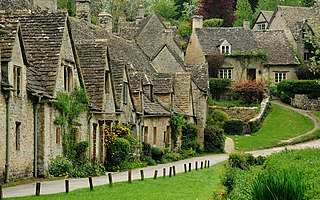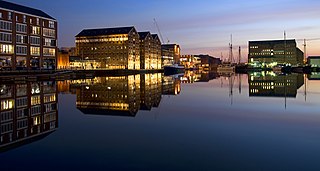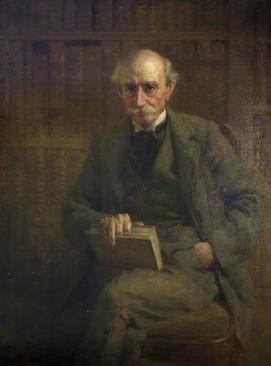
Gloucestershire is a ceremonial county in South West England. It is bordered by Herefordshire to the north-west, Worcestershire to the north, Warwickshire to the north-east, Oxfordshire to the east, Wiltshire to the south, Bristol and Somerset to the south-west, and the Welsh county of Monmouthshire to the west. The city of Gloucester is the largest settlement and the county town.

Gloucester is a cathedral city and the county town of Gloucestershire in the South West of England. Gloucester lies on the River Severn, between the Cotswolds to the east and the Forest of Dean to the west; it is sited 19 miles (31 km) east of Monmouth and 17 miles (27 km) east of the border with Wales. Gloucester has a population of around 132,000, including suburban areas. It is a port, linked via the Gloucester and Sharpness Canal to the Severn Estuary.

Stroud is a market town and civil parish in Gloucestershire, England. It is the main town in Stroud District. The town's population was 13,500 in 2021.

Painswick is a town and civil parish in the Stroud District in Gloucestershire, England. Originally the town grew from the wool trade, but it is now best known for its parish church's yew trees and the local Rococo Garden. The village is mainly constructed of locally quarried Cotswold stone. Many of the buildings feature south-facing attic rooms once used as weavers' workshops.

The Dobunni were one of the Iron Age tribes living in the British Isles prior to the Roman conquest of Britain. There are seven known references to the tribe in Roman histories and inscriptions.

Aust is a small village in South Gloucestershire, England, about 10 miles (16 km) north of Bristol and about 28 miles (45 km) south west of Gloucester. It is located on the eastern side of the Severn estuary, close to the eastern end of the Severn Bridge which carries the M48 motorway. The village has a chapel, a church and a public house. There is a large area of farmland on the river bank, which is sometimes flooded due to the high tidal range of the Severn. Aust Cliff, above the Severn, is located about 0.5 miles (0.80 km) from the village. The civil parish of Aust includes the villages of Elberton and Littleton-upon-Severn.

The region now known as Gloucestershire was originally inhabited by Brythonic peoples in the Iron Age and Roman periods. After the Romans left Britain in the early 5th century, the Brythons re-established control but the territorial divisions for the post-Roman period are uncertain. The city of Caerloyw was one centre and Cirencester may have continued as a tribal centre as well. The only reliably attested kingdom is the minor south-east Wales kingdom of Ergyng, which may have included a portion of the area. In the final quarter of the 6th century, the Saxons of Wessex began to establish control over the area.

Arlingham is a village and civil parish in the Stroud District of Gloucestershire, England. The 2021 Census recorded a parish population of 533. The parish contains the hamlets of Milton End, Overton and Priding. The next parish to the east is Fretherne with Saul.

Sheppard Sunderland Frere, CBE, FSA, FBA was a British historian and archaeologist who studied the Roman Empire. He was a fellow at All Souls College, Oxford.

Robert Fitzharding was an Anglo-Saxon nobleman from Bristol who was granted the feudal barony of Berkeley in Gloucestershire. He rebuilt Berkeley Castle, and founded the Berkeley family which still occupies it today. He was a wealthy Bristol merchant and a financier of the future King Henry II of England (1133-1189) in the period known as the Anarchy during which Henry's mother, the Empress Matilda (1102-1167), mounted repeated military challenges to King Stephen. Fitzharding founded St. Augustine's Abbey, which after the Reformation became Bristol Cathedral. Many members of the Berkeley family were buried within it, and some of their effigies survive there. As J. Horace Round asserted he was one of the very few Anglo-Saxon noblemen who managed to retain their noble status in Norman England and successfully integrate with the Norman nobility, if not the only one.

The Gloucestershire Rugby Football Union is the union responsible for rugby union in the county of Gloucestershire, England and is one of the constituent bodies of the national Rugby Football Union. Formed in 1878, it has won the county championship on numerous occasions.
Carolyn Mary Heighway FSA is an archaeological consultant to Gloucester Cathedral and the owner, with her husband Richard Maurice Bryant, of Past Historic, a company which specialises in the design and production of archaeological books and journals as well as exhibitions. She was a founder trustee of Cotswold Archaeology in 1989, and is a fellow of the Society of Antiquaries of London. She is a former president of the Bristol and Gloucestershire Archaeological Society.

The Rev. Prebendary James Dallaway FSA was an English antiquary, topographer, and miscellaneous writer. He is known for his account of Constantinople and the Greek islands, published in 1797; and his county history of the western parts of Sussex, of which he published two volumes in 1815–19.

Nicholas Hyett (1709-1777) was a lawyer and justice of the peace in Gloucester, England, and one of the last keepers and constables of the Castle of Gloucester.

Sir Francis Adams Hyett (1844–1941) was chairman of Gloucestershire County Council from 1918 to 1920.

Thomas Fulljames FRIBA was an architect active in Gloucestershire, England, in the first half of the nineteenth century. As diocesan surveyor from 1832 until 1870, latterly in partnership with Frederick Sandham Waller, he designed, reconstructed or extended a number of churches in Gloucestershire.

George Worrall Counsel was a Gloucester solicitor, antiquarian, alderman, and property developer.
Irvine Egerton Gray MBE FSA was an antiquarian and archivist of Gloucestershire. He served in the British Army during the Second World War, rising to the rank of major in the Intelligence Corps, and after the war worked as records officer for Gloucestershire County Council. A member of the Bristol and Gloucestershire Archaeological Society, he was the author and editor of a number of works on the history of Gloucestershire.

Canon John Eric Gethyn-Jones MBE FSA was a clergyman and historian of Gloucestershire. He served in the Royal Army Chaplains' Department during the Second World War for which he was awarded the MBE in 1945. Later he was vicar of St Mary of the Virgin's Church, Berkeley, and rose to the position of Canon. He wrote a number of works including books on the history of Dymock and Berkeley, Gloucestershire.

















